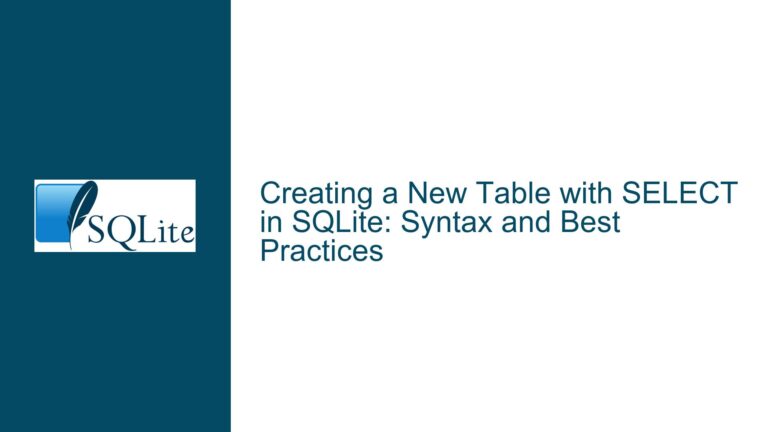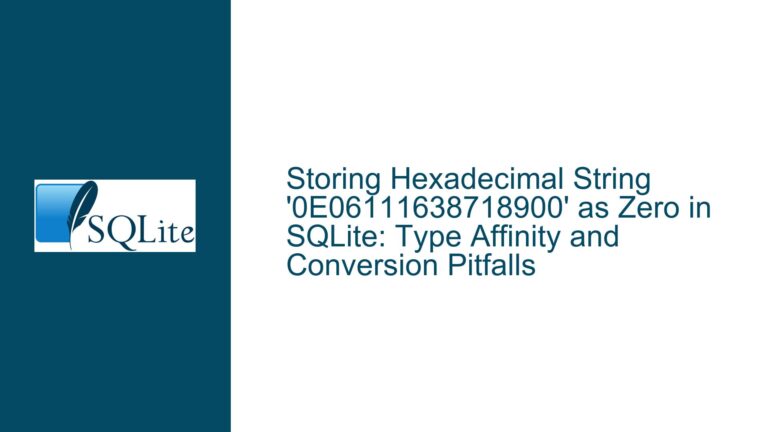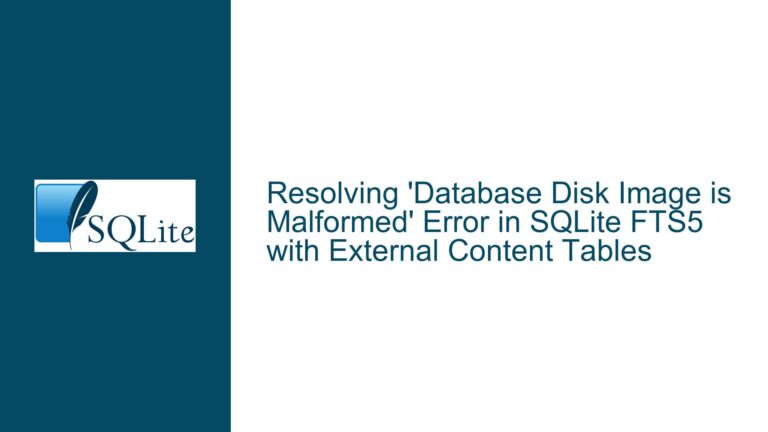Tracking Transaction-Specific Changes in SQLite Triggers Without Built-in Transaction IDs
Issue Overview: Absence of Native Transaction Identification in Multi-Table Operations
SQLite does not natively expose transaction identifiers (IDs) that can be programmatically accessed within triggers or application logic. This creates a challenge when attempting to associate database changes with specific transactions, particularly in scenarios involving multiple tables. For example, consider a transaction that inserts records into two tables, a and b, within a single atomic operation:
BEGIN;
INSERT INTO a(id) VALUES(1);
INSERT INTO b(id) VALUES(2);
COMMIT;
The goal is to log these changes in a changelog table with a shared transaction_id, enabling traceability of all modifications made within the same transaction. The absence of a built-in mechanism to retrieve a transaction ID forces developers to implement workarounds. Key challenges include:
- Atomic Transaction Scope: Transactions in SQLite are atomic but lack a user-facing identifier. All operations within
BEGINandCOMMIT/ROLLBACKare treated as a single unit, but there is no direct way to tag individual row changes with a shared transaction marker. - Trigger Execution Context: Triggers fire per statement, not per transaction. If two
INSERTstatements are executed within a transaction, their corresponding triggers will run independently, with no inherent knowledge that they belong to the same transaction. - Rollback Handling: Any solution must account for transaction rollbacks. Logged changes associated with rolled-back transactions should either be automatically discarded or explicitly invalidated.
Possible Causes: Why Native Transaction Identification Is Not Feasible
- SQLite’s Transaction Isolation Model: SQLite uses a lock-based concurrency model where transactions are serialized. While this ensures atomicity, it does not expose internal transaction states or identifiers to userland code.
- Ephemeral Transaction Context: Transaction boundaries are managed internally, and no persistent metadata (e.g., a monotonically increasing transaction counter) is retained after a transaction completes. This design avoids overhead but limits visibility.
- Trigger Execution Scope: Triggers operate within the context of the statement that invoked them, not the encompassing transaction. Thus, they cannot directly access information about the broader transaction.
- Resource Constraints: As a lightweight database, SQLite prioritizes simplicity and minimal resource usage. Features like transaction IDs are deemed non-essential for typical use cases, relegating their implementation to userland solutions.
Troubleshooting Steps, Solutions & Fixes: Implementing Transaction ID Tracking
Solution 1: User-Defined Function (UDF) for Transaction ID Generation
Overview: Create a custom UDF that generates and returns a transaction-specific identifier. This function can maintain a static variable incremented at the start of each transaction, ensuring all triggers within the transaction access the same ID.
Implementation Steps:
Define the UDF:
#include <sqlite3ext.h> SQLITE_EXTENSION_INIT1 static int current_transaction_id = 0; static void get_transaction_id( sqlite3_context *context, int argc, sqlite3_value **argv ) { if (argc == 1) { current_transaction_id = sqlite3_value_int(argv[0]); } sqlite3_result_int(context, current_transaction_id); } int sqlite3_extension_init( sqlite3 *db, char **pzErrMsg, const sqlite3_api_routines *pApi ) { SQLITE_EXTENSION_INIT2(pApi); sqlite3_create_function_v2( db, "transaction_id", 0, // Number of arguments; use -1 for variable SQLITE_UTF8 | SQLITE_DETERMINISTIC, NULL, get_transaction_id, NULL, NULL, NULL ); return SQLITE_OK; }Compile this into a loadable extension (e.g.,
transaction_id.soortransaction_id.dll).Load the Extension in SQLite:
SELECT load_extension('/path/to/transaction_id');Set the Transaction ID at Transaction Start:
BEGIN; SELECT transaction_id(COALESCE((SELECT MAX(transaction_id) FROM changelog), 0) + 1); INSERT INTO a(id) VALUES(1); -- Trigger logs with transaction_id() INSERT INTO b(id) VALUES(2); -- Trigger logs with transaction_id() COMMIT;Define Triggers to Use the UDF:
CREATE TRIGGER log_a AFTER INSERT ON a BEGIN INSERT INTO changelog(table_name, transaction_id) VALUES ('a', transaction_id()); END; CREATE TRIGGER log_b AFTER INSERT ON b BEGIN INSERT INTO changelog(table_name, transaction_id) VALUES ('b', transaction_id()); END;
Advantages:
- Guarantees a unique, transaction-specific ID.
- Minimal performance overhead after UDF initialization.
Drawbacks:
- Requires compiling and distributing a SQLite extension.
- Not thread-safe by default (requires mutexes if used in multi-threaded environments).
Solution 2: Sequence Table with Temporary Transaction Context
Overview: Use a combination of a sequence table to generate IDs and a temporary table to track the current transaction’s ID. This approach avoids extensions but requires careful management of temporary state.
Implementation Steps:
Create a Sequence Table:
CREATE TABLE transaction_seq ( id INTEGER PRIMARY KEY AUTOINCREMENT );Create a Temporary Table for Session-Specific State:
CREATE TEMP TABLE current_transaction ( txid INTEGER );Define Triggers to Initialize and Use Transaction IDs:
CREATE TRIGGER begin_transaction AFTER BEGIN BEGIN INSERT INTO transaction_seq DEFAULT VALUES; INSERT INTO current_transaction (txid) VALUES (last_insert_rowid()); END;Note: SQLite does not support
AFTER BEGINtriggers. As a workaround, use a dummy table and aBEFORE INSERTtrigger on the first operation in each transaction.Workaround Using a Dummy Table:
CREATE TABLE dummy (id INTEGER); CREATE TRIGGER start_tx BEFORE INSERT ON dummy BEGIN INSERT INTO transaction_seq DEFAULT VALUES; INSERT INTO current_transaction (txid) VALUES (last_insert_rowid()); END;Modify Transactions to Activate the Trigger:
BEGIN; INSERT INTO dummy DEFAULT VALUES; -- Activates start_tx trigger INSERT INTO a(id) VALUES(1); INSERT INTO b(id) VALUES(2); COMMIT;Log Changes Using the Temporary Table:
CREATE TRIGGER log_a AFTER INSERT ON a BEGIN INSERT INTO changelog(table_name, transaction_id) VALUES ('a', (SELECT txid FROM current_transaction)); END;
Advantages:
- Pure SQL implementation without extensions.
- Transaction IDs are reset automatically on transaction boundaries.
Drawbacks:
- Relies on inserting into a dummy table at the start of each transaction, which may not be feasible if application SQL cannot be modified.
- Temporary tables are session-specific, complicating use in connection-pooled environments.
Solution 3: Hybrid Timestamp-Counter Approach
Overview: Combine high-precision timestamps with a per-transaction counter to generate unique IDs. This method leverages SQLite’s julianday('now') and random() functions but requires careful handling to avoid collisions.
Implementation Steps:
Create a Changelog Table with Composite ID:
CREATE TABLE changelog ( id INTEGER PRIMARY KEY, table_name TEXT, transaction_timestamp REAL, transaction_counter INTEGER );Initialize a Temporary Counter at Transaction Start:
CREATE TEMP TABLE tx_state ( timestamp REAL, counter INTEGER );Define Triggers to Manage State:
CREATE TRIGGER init_tx_state AFTER BEGIN BEGIN INSERT INTO tx_state(timestamp, counter) VALUES (julianday('now'), 0); END;Note: Replace
AFTER BEGINwith a workaround as in Solution 2 if necessary.Increment Counter on Each Trigger Invocation:
CREATE TRIGGER log_a AFTER INSERT ON a BEGIN UPDATE tx_state SET counter = counter + 1 WHERE timestamp = (SELECT timestamp FROM tx_state); INSERT INTO changelog(table_name, transaction_timestamp, transaction_counter) VALUES ('a', (SELECT timestamp FROM tx_state), (SELECT counter FROM tx_state)); END;
Advantages:
- No extensions or sequence tables required.
- Naturally groups changes by transaction start time.
Drawbacks:
- Potential for timestamp collisions under high concurrency.
- Increased storage overhead due to composite identifiers.
Final Considerations
- Rollback Handling: In all solutions, changelog entries are part of the transaction and automatically rolled back if the transaction is aborted. This ensures consistency.
- Concurrency: Solutions involving temporary tables or UDFs with static variables are safe in SQLite’s serialized write model but may require additional synchronization in multi-threaded applications.
- Performance: UDF-based solutions offer the lowest overhead, while timestamp-counter hybrids may incur measurable latency under high load.
Choose the approach that best aligns with your control over the SQL environment, performance requirements, and tolerance for external dependencies.





